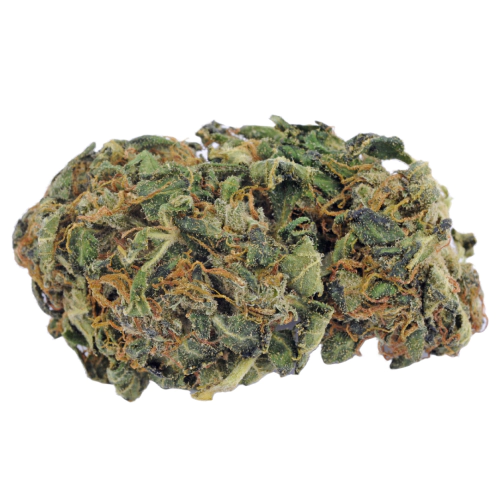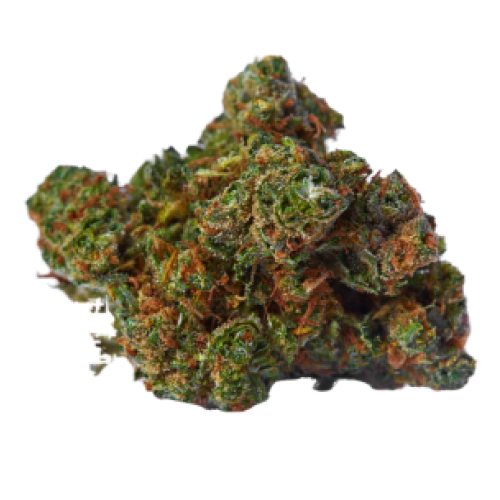THC 19.8 - 21.2%
CBD 0.35 - 0.81%
Effect Tingly
Flavor Citrus
20 - 21%
0.66 - 0.88%
0.49 - 0.66%
Woody, Flowery
Sleepy
Vanilla Cream Pie is a strain with a perfect balance of Sativa and Indica (50/50) that demonstrates a THC level of 20-21%. The CBD content is low and amounts to 0.66-0.88%. Cannabinoids that naturally occur in this hybrid are as follows:
I grew a couple rounds from seed (Humbolt Seed Co). At first I wasn't super impressed. That was until I upped my nutes in my second grow. They went crazy. This strain definitly likes extra nutes. They were really happy with extra nitrogen during veg. It aslo naturally likes to turn purple and makes for a nice finish product. Great smell and flavor, will definitly grow again.
Hypersensitive smokers and first-timers are recommended to avoid this powerful marijuana type or try it with the smallest dose.
This cannabis hybrid has a deep and memorable aroma; however, it is far from the strain’s name. The smells are flowery and woody on initial inspection, with slight lemon notes as typical for caryophyllene. On a deeper whiff, smokers can detect tobacco and lemon odors. On the exhale, the weed leaves more pleasant flavors reminiscent of limonene, myrcene, and humulene.
After people smoke the Vanilla Cream Pie strain, one of the most common effects they experience is sleepiness. Their bodies drop off into a state of total relaxation that can make it difficult to move at times. This effect is widely used to help people combat symptoms caused by:
The strain is less powerful but still effective in managing epilepsy, muscle spasms, bipolar disorder, and Alzheimer’s disease.
The THC percentage is thought to be a reason for causing side effects in smokers such as:
These reactions are more likely to occur when smoking large amounts of Vanilla Cream Pie at a time. For consumers who worry about the risk of these reactions, it is best to stick to smaller doses.
It is not a challenge to cultivate the Vanilla Cream Pie strain, and this fact adds more points to this hybrid. The typical flowering time is 55-63 days, and the harvest is expected in 59 days. For indoor plants that grow up to 30’’-60’’, it amounts to 1-2 oz./ft2, while outdoor yields can be 10-15 ounces per plant. Grown in the open air, they are 60’’-80’’ in stature.
| THC | Tetrahydrocannabinol, or THC, is a major cannabis chemical compound. It is a psychoactive element that stimulates dopamine release and induces euphoria or happiness. THC-rich strains may be helpful with such conditions as lack of appetite, chronic pains , etc. It is considered to be the primary active marijuana component. | 20 - 21% |
| CBD | Cannabidiol, or CBD, is a major compound in cannabis, which is non-psychoactive. It is also proved to counteract the side effects of the second major component THC. CBD is widely used for medicinal purposes in rubs, oils and so on. It is helpful in muscle pain cases, may treat arthritis and migraines. Even Greeks used it against pain, while Queen Victoria applied it to get rid of menstrual cramps. | 0.66 - 0.88% |
| CBC | Cannabichromene, or CBC, is a minor cannabinoid, meaning that its quantity in cannabis is quite little. Though it has the same origin as CBD and THC, it is different in functions. Without any psychoactive effects, it is an efficient cannabis compound in combating acne and depression. CBC produces analgesic, antibacterial and anti-inflammatory effects. | 0.09 - 0.16% |
| CBG | Cannabigerol, or CBG, is one of the minor cannabis compounds in adult plants. On the other hand, young ones contain a lot of this antibacterial and anti-inflammatory component. During the growth, CBG is converted into different cannabinoids, mostly THC and CBD. The compound itself increases appetite and decreases eye pressure. | 0.49 - 0.66% |
| CBN | Cannabinol, or CBN, is a trace element in cannabis that is considered to be mildly psychoactive. It appears from oxidation THC, exposed to light and heat. CBN is mostly contained in old cannabis and in traditional hashish. It is effective against insomnia, bacterial infections and appetite loss. | 0.08 - 0.28% |
| THCV | Tetrahydrocannabivarin, or THC-V, is a compound contained in cannabis in trace amounts. Even though it is close to THC molecularly, it is different in effects. This compound may be psychoactive only in large amounts. THC-V reduces blood sugar, controls appetite, stimulates bone growth, etc. African Sativa strains are the richest in THC-V. | 0.05 - 0.07% |
| Pinene | Pinene is one of the most widespread terpenes in nature, found in pine trees, basil, nutmeg, parsley, and rosemary. Cannabis containing terpene (alpha-pinene or α-pinene) boasts a strong pine scent. Pinene is responsible for anti-inflammatory, pain-relieving, and anti-anxiety effects. | 0.05% |
| Borneol | Borneol is a terpene with a woody, camphor-like aroma, naturally occurring in ginger, rosemary, camphor, and thyme. Borneol has been used in traditional Chinese medicine for thousands of years as an anti-inflammatory, pain-relieving, and anticoagulant means. Borneol has the distinctive property of boosting the effects of medical drugs. In cannabis, Borneol is one of the most commonly occurring terpenes. | 0.07% |
| Myrcene | Myrcene (also known as β-myrcene) is one of the most common terpenes found in cannabis, representing more than 20% of the modern marijuana terpene profile. Myrcene has a distinct earthy, musky flavor, resembling cloves. It is responsible for calming and soothing effects of weed. Myrcene is also found in hops, thyme, mango, lemongrass, guava melon. | 0.14% |
| Humulene | Humulene (also known as α-humulene) is one of the major terpenes found in cannabis, contributing to woody, earthy, spicy, herbaceous, and, mainly, floral aromas of cannabis. Used in modern medicine, humulene offers anti-inflammatory, antibacterial, and appetite suppressant effects, which have been well-researched by pharmaceutical companies. | 0.1% |
| Limonene | Limonene (also known as d-limonene) is the second most common terpene in nature and the third most common terpene in cannabis. It has a powerful citrus aroma and can be found in all citruses, including lemons, oranges, grapefruits, limes, juniper, etc. Limonene is known to elevate moods and provide anxiety, depression, and stress relief. | 0.15% |
| Linalool | Linalool (also known as beta linalool, linalyl alcohol, linaloyl oxide, and p-linalool) is one of the rarest terpenes found in cannabis, mostly in small quantities. Linalool is known for its spicy and lavender aroma, bringing relaxation and calming effects. It is also said to provide anti-inflammatory and analgesic properties that can be useful for athletes. | 0.07% |
| Bisabolol | Bisabolol (also known as α-Bisabolol or levomenol) is a lesser-known terpene found in cannabis. It contributes to anti-inflammatory, anti-irritant, antioxidant, anti-microbial, and analgesic properties of weed strains containing bisanol. Attentive smokers would be able to catch a nutty, fruity scent with herbal and floral undertones, with a tender trace of coconut. | 0.08% |
| Eucalyptol | Eucalyptol (also known as cineole) is usually found in eucalyptus, mint, sage, and tea tree oil. Distinguished for its cooling properties, eucalyptol constitutes only up 0.6% of a total terpene profile of a strain. This terpene exhibits potent antibacterial effects and can also be used to treat patients with Alzheimer's disease and asthma. | 0.03% |
| Caryophyllene | Caryophyllene (also known as beta or b caryophyllene) is a terpene found in many herbs and spices, such as black pepper, basil, rosemary, and oregano. Cannabis high in caryophyllene delivers a strong spicy, peppery aroma, resembling cinnamon and cloves. Caryophyllene offers potent anti-inflammatory and sedative effects. | 0.3% |
| Total terpenes content | 0.99% |
THC 19.8 - 21.2%
CBD 0.35 - 0.81%
Effect Tingly
Flavor Citrus
THC 15.5 - 17.5%
CBD 0.68 - 0.9%
Effect Creative
Flavor Lemon
THC 15.25 - 17.75%
CBD 0.19 - 0.5%
Effect Relaxed
Flavor Earthy

THC 15.33 - 18%
CBD 0.32 - 0.56%
Effect Sleepy
Flavor Pungent

THC 15.2 - 17%
CBD 0.22 - 0.56%
Effect Uplifted
Flavor Spicyherbal
THC 13.5 - 19%
CBD 0.04 - 0.38%
Effect Relaxed
Flavor Pungent
THC 14.5 - 18.5%
CBD 0.1 - 0.91%
Effect Tingly
Flavor Citrus
THC 18.5 - 21%
CBD 0.23 - 0.52%
Effect Giggly
Flavor Chemical
THC 13 - 15.88%
CBD 0.58 - 0.77%
Effect Concentrated
Flavor Skunk
THC 20 - 23%
CBD 1.17 - 1.36%
Effect Happy
Flavor Sweet
THC 15 - 23%
CBD 0.22 - 1.02%
Effect Sedated
Flavor Earthy
THC 13.18 - 16.4%
CBD 0.31 - 1.17%
Effect Uplifted
Flavor Skunk
THC 19 - 22%
CBD 0.1 - 0.58%
Effect Calm
Flavor Mint
THC 13.2 - 16.38%
CBD 0.02 - 0.29%
Effect Sleepy
Flavor Spicyherbal
THC 20 - 22%
CBD 0.66 - 0.94%
Effect Calm
Flavor Spicyherbal
THC 32 - 36%
CBD 0.21 - 0.44%
Effect Happy
Flavor Lemon
THC 9.5 - 11.5%
CBD 0.01 - 0.18%
Effect Creative
Flavor Pear
THC 20.67 - 23.67%
CBD 0.37 - 0.6%
Effect Creative
Flavor Spicyherbal
THC 13.97 - 17.36%
CBD 0.23 - 1.04%
Effect Giggly
Flavor Tea
User Reviews 1
I grew a couple rounds from seed (Humbolt Seed Co). At first I wasn't super impressed. That was until I upped my nutes in my second grow. They went crazy. This strain definitly likes extra nutes. They were really happy with extra nitrogen during veg. It aslo naturally likes to turn purple and makes for a nice finish product. Great smell and flavor, will definitly grow again.
Write a Review